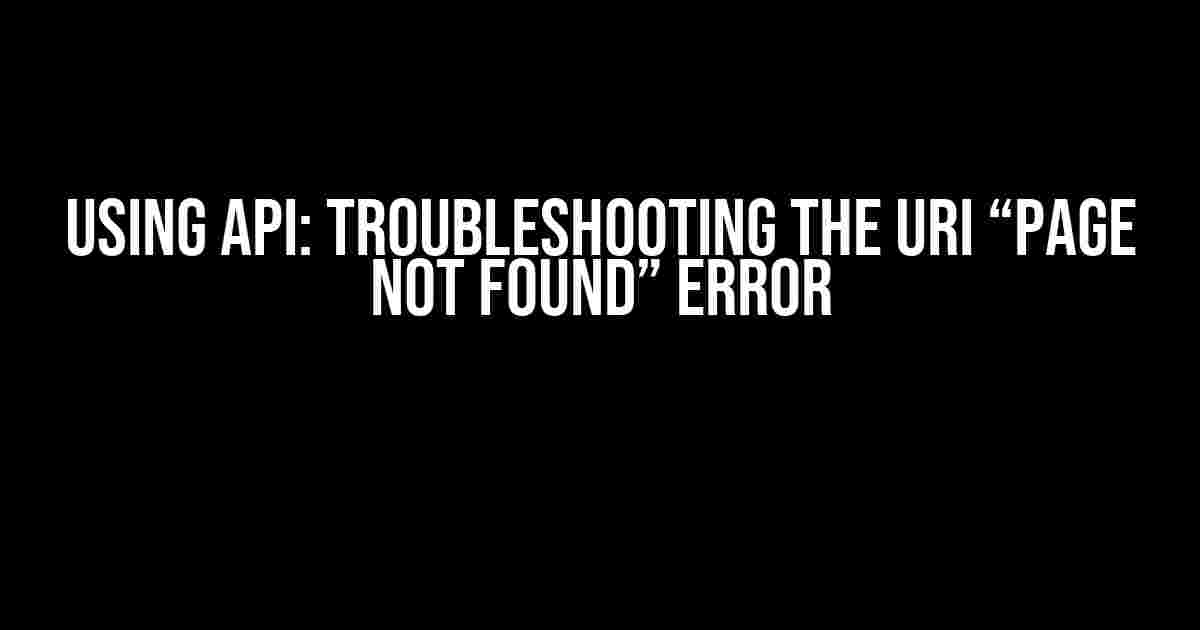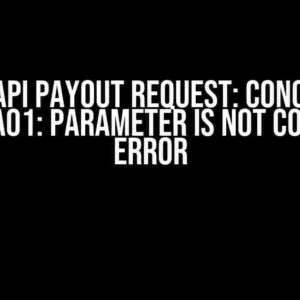Are you pulling your hair out trying to figure out why your API request is returning a “Page Not Found” error? You’re not alone! In this article, we’ll dive into the common causes of this frustrating issue and provide you with practical solutions to get your API working smoothly again.
What is a URI and How Does it Relate to API?
A Uniform Resource Identifier (URI) is a string of characters used to identify a resource on the internet. In the context of APIs, a URI is used to specify the location of the API endpoint. Think of it like a URL, but instead of accessing a website, it’s used to interact with an API.
https://api.example.com/users
In the example above, the URI is `https://api.example.com/users`, which is used to retrieve a list of users from the API.
Common Causes of the “Page Not Found” Error
Before we dive into the solutions, let’s explore the common causes of the “Page Not Found” error when using an API:
- Invalid URI: A typo or incorrect syntax in the URI can result in a “Page Not Found” error.
- Non-Existent Endpoint: The API endpoint may not exist, or the URI is pointing to a non-existent resource.
- Authentication Issues: Failing to provide the necessary authentication credentials or using incorrect credentials can lead to a “Page Not Found” error.
- Rate Limiting: Exceeding the API’s rate limit can result in a “Page Not Found” error.
- Server-Side Issues: Server-side errors, such as downtime or maintenance, can cause a “Page Not Found” error.
Troubleshooting Steps
Now that we’ve covered the common causes, let’s go through some troubleshooting steps to help you identify and fix the issue:
-
Verify the URI
Double-check the URI for any typos or incorrect syntax. Make sure it matches the documentation provided by the API vendor.
-
Check the API Documentation
Review the API documentation to ensure the endpoint exists and you’re using the correct HTTP method (e.g., GET, POST, PUT, DELETE).
-
Authentication and Authorization
Verify that you’re providing the necessary authentication credentials, such as API keys or tokens, and that they’re correct.
-
Rate Limiting
Check the API’s rate limit and ensure you’re not exceeding it. You can usually find this information in the API documentation or by contacting the API vendor.
-
Server-Side Issues
Check the API vendor’s status page or social media accounts to see if there are any reported issues or maintenance scheduled.
Testing and Debugging
Once you’ve gone through the troubleshooting steps, it’s time to test and debug your API request:
curl -X GET \ https://api.example.com/users \ -H 'Authorization: Bearer YOUR_API_KEY' \ -H 'Content-Type: application/json'
In the example above, we’re using the `curl` command to send a GET request to the `https://api.example.com/users` endpoint, providing an API key in the `Authorization` header and specifying `application/json` as the content type.
If you’re still encountering issues, try using a tool like Postman or a web debugging proxy like Fiddler to inspect the API request and response.
Common API URI Examples
Here are some common API URI examples:
| API Endpoint | URI |
|---|---|
| Get User Information | https://api.example.com/users/{user_id} |
| Get List of Users | https://api.example.com/users |
| Create New User | https://api.example.com/users |
| Update User Information | https://api.example.com/users/{user_id} |
| Delete User | https://api.example.com/users/{user_id} |
Note: Replace `{user_id}` with the actual ID of the user you want to interact with.
Conclusion
By following the troubleshooting steps and testing your API request, you should be able to identify and fix the “Page Not Found” error. Remember to always verify the URI, check the API documentation, and ensure you’re providing the necessary authentication credentials. If you’re still stuck, don’t hesitate to reach out to the API vendor’s support team for assistance.
Now, go forth and API-ify the world!
Frequently Asked Question
API URI woes got you down? Don’t worry, we’ve got the answers!
Why is my API URI returning a 404 Page Not Found error?
Double-check that your URI is correctly formatted and that the endpoint exists. Make sure to check for any typos or incorrect capitalization. Also, verify that the API is enabled and the endpoint is properly configured. If you’re still stuck, try testing your API using a tool like Postman or cURL to isolate the issue.
I’ve checked the URI, but I’m still getting a 404 error. What’s next?
It’s time to dig deeper! Check the API documentation to ensure you’re using the correct HTTP method (GET, POST, PUT, etc.). Also, verify that you’re passing the correct parameters and headers in your request. If you’re using authentication, ensure your credentials are valid and properly formatted.
Could the issue be related to API rate limiting or throttling?
Yes, it’s possible! API rate limiting or throttling can cause issues with your URI. Check the API documentation to see if there are any rate limits or throttling restrictions in place. If so, try slowing down your request rate or implement a retry mechanism to handle temporary errors.
What if I’m using a proxy or load balancer? Could that be causing the issue?
Ah-ha! Yes, proxies or load balancers can sometimes cause issues with API URIs. Check your proxy or load balancer configuration to ensure it’s not interfering with your API requests. You may need to whitelist the API endpoint or adjust the proxy settings to resolve the issue.
I’ve tried everything, but I’m still stuck! What’s my next step?
Don’t worry, we’ve all been there! If you’ve exhausted all troubleshooting options, it’s time to seek help from the API provider’s support team or a developer community. Provide as much detail as possible about your issue, including any error messages, and they should be able to assist you in resolving the problem.







